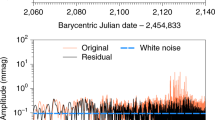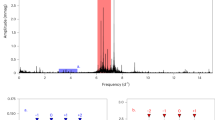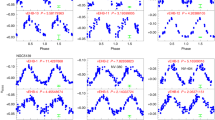Abstract
Studies using asteroseismic ages and rotation rates from star-spot rotation have indicated that standard age–rotation relations may break down roughly half way through the main sequence lifetime, a phenomenon referred to as weakened magnetic braking. Although rotation rates from spots can be difficult to determine for older, less active stars, rotational splitting of asteroseismic oscillation frequencies can provide rotation rates for both active and quiescent stars, and so can confirm whether this effect really takes place on the main sequence. We obtained asteroseismic rotation rates of 91 main sequence stars showing high signal-to-noise modes of oscillation. Using these new rotation rates, along with effective temperatures, metallicities and seismic masses and ages, we built a hierarchical Bayesian mixture model to determine whether the ensemble more closely agreed with a standard rotational evolution scenario, or one where weakened magnetic braking takes place. The weakened magnetic braking scenario was found to be 98.4% more likely for our stellar ensemble, adding to the growing body of evidence for this stage of stellar rotational evolution. This work presents a large catalogue of seismic rotation rates for stars on the main sequence, which opens up possibilities for more detailed ensemble analysis of rotational evolution with Kepler.
This is a preview of subscription content, access via your institution
Access options
Access Nature and 54 other Nature Portfolio journals
Get Nature+, our best-value online-access subscription
$29.99 / 30 days
cancel any time
Subscribe to this journal
Receive 12 digital issues and online access to articles
$119.00 per year
only $9.92 per issue
Buy this article
- Purchase on Springer Link
- Instant access to full article PDF
Prices may be subject to local taxes which are calculated during checkout




Similar content being viewed by others
Data availability
The core input data and results are summarized in Supplementary Table 1, which is available in a machine-readable format as Supplementary Data 1. Larger data files, such as stellar model populations and individual posterior distribution chains from the asteroseismic and gyrochronology model fitting are fully available on request from the corresponding author. This work made use of publicly available data. Kepler power spectral densities were obtained from the KASOC webpages for the majority of stars, and from the MAST for 16 Cyg A and B. This work used asteroseismic data from refs. 7,22,23,24. Parameter distributions of the Kepler field used to alter our stellar population models were taken from ref. 36.
Code availability
The code required to replicate our results has been placed in a curated online repository at www.github.com/ojhall94/halletal2021. All code written in the duration of this project, along with a full commit history, can be found in an uncurated online repository at www.github.com/ojhall94/malatium. The code used to construct the stellar population models used in this work is available upon request from the corresponding author.
References
Barnes, S. A. Ages for illustrative field stars using gyrochronology: viability, limitations, and errors. Astrophys. J. 669, 1167–1189 (2007).
Meibom, S. et al. A spin-down clock for cool stars from observations of a 2.5-billion-year-old cluster. Nature 517, 589–591 (2015).
Leiner, E., Mathieu, R. D., Vanderburg, A., Gosnell, N. M. & Smith, J. C. Blue Lurkers: hidden blue stragglers on the M67 main sequence identified from their Kepler/K2 rotation periods. Astrophys. J. 881, 47 (2019).
Claytor, Z. R. et al. Chemical evolution in the Milky Way: rotation-based ages for APOGEE-Kepler cool dwarf stars. Astrophys. J. 888, 43 (2020).
Barnes, S. A., Weingrill, J., Fritzewski, D., Strassmeier, K. G. & Platais, I. Rotation periods for cool stars in the 4 Gyr old Open Cluster M67, the solar-stellar connection, and the applicability of gyrochronology to at least solar age. Astrophys. J. 823, 16 (2016).
Borucki, W. J. et al. Kepler planet-detection mission: introduction and first results. Science 327, 977–980 (2010).
Silva Aguirre, V. et al. Ages and fundamental properties of Kepler exoplanet host stars from asteroseismology. Mon. Not. R. Astron. Soc. 452, 2127–2148 (2015).
Angus, R., Aigrain, S., Foreman-Mackey, D. & McQuillan, A. Calibrating gyrochronology using Kepler asteroseismic targets. Mon. Not. R. Astron. Soc. 450, 1787–1798 (2015).
Nielsen, M. B., Schunker, H., Gizon, L. & Ball, W. H. Constraining differential rotation of Sun-like stars from asteroseismic and starspot rotation periods. Astron. Astrophys. 582, A10 (2015).
Davies, G. R. et al. Asteroseismic inference on rotation, gyrochronology and planetary system dynamics of 16 Cygni. Mon. Not. R. Astron. Soc. 446, 2959–2966 (2015).
van Saders, J. L. et al. Weakened magnetic braking as the origin of anomalously rapid rotation in old field stars. Nature 529, 181–184 (2016).
Réville, V., Brun, A. S., Matt, S. P., Strugarek, A. & Pinto, R. F. The effect of magnetic topology on thermally driven wind: toward a general formulation of the braking law. Astrophys. J. 798, 116 (2015).
Garraffo, C., Drake, J. J. & Cohen, O. The missing magnetic morphology term in stellar rotation evolution. Astron. Astrophys. 595, A110 (2016).
Metcalfe, T. S., Egeland, R. & van Saders, J. Stellar evidence that the solar dynamo may be in transition. Astrophys. J. Lett. 826, L2 (2016).
Metcalfe, T. S. et al. LBT/PEPSI spectropolarimetry of a magnetic morphology shift in old solar-type stars. Astrophys. J. 887, L38 (2019).
See, V. et al. Do non-dipolar magnetic fields contribute to spin-down torques? Astrophys. J. 886, 120 (2019).
McQuillan, A., Mazeh, T. & Aigrain, S. Rotation periods of 34,030 Kepler main-sequence stars: the full autocorrelation sample. Astrophys. J. Suppl. Ser. 211, 24 (2014).
Matt, S. P., Brun, A. S., Baraffe, I., Bouvier, J. & Chabrier, G. The mass-dependence of angular momentum evolution in Sun-like stars. Astrophys. J. 799, L23 (2015).
Reinhold, T. et al. The Sun is less active than other solar-like stars. Science 368, 518–521 (2020).
van Saders, J. L., Pinsonneault, M. H. & Barbieri, M. Forward modeling of the Kepler stellar rotation period distribution: interpreting periods from mixed and biased stellar populations. Astrophys. J. 872, 128 (2019).
Ledoux, P. The nonradial oscillations of gaseous stars and the problem of Beta Canis Majoris. Astrophys. J. 114, 373 (1951).
Davies, G. R. et al. Oscillation frequencies for 35 Kepler solar-type planet-hosting stars using Bayesian techniques and machine learning. Mon. Not. R. Astron. Soc. 456, 2183–2195 (2016).
Lund, M. N. et al. Standing on the shoulders of dwarfs: the Kepler Asteroseismic LEGACY sample. I. Oscillation mode parameters. Astrophys. J. 835, 172 (2017).
Silva Aguirre, V. et al. Standing on the shoulders of dwarfs: the Kepler asteroseismic LEGACY sample. II. Radii, masses, and ages. Astrophys. J. 835, 173 (2017).
García, R. A. et al. Rotation and magnetism of Kepler pulsating solar-like stars. Towards asteroseismically calibrated age-rotation relations. Astron. Astrophys. 572, A34 (2014).
Kraft, R. P. Studies of stellar rotation. V. The dependence of rotation on age among solar-type stars. Astrophys. J. 150, 551 (1967).
Bedding, T. R. et al. Solar-like oscillations in low-luminosity red giants: first results from Kepler. Astrophys. J. Lett. 713, L176–L181 (2010).
Benomar, O. et al. Asteroseismic detection of latitudinal differential rotation in 13 Sun-like stars. Science 361, 1231–1234 (2018).
Lund, M. N., Miesch, M. S. & Christensen-Dalsgaard, J. Differential rotation in main-sequence solar-like stars: qualitative inference from asteroseismic data. Astrophys. J. 790, 121 (2014).
Benomar, O., Takata, M., Shibahashi, H., Ceillier, T. & García, R. A. Nearly uniform internal rotation of solar-like main-sequence stars revealed by space-based asteroseismology and spectroscopic measurements. Mon. Not. R. Astron. Soc. 452, 2654–2674 (2015).
Gizon, L. et al. Seismic constraints on rotation of Sun-like star and mass of exoplanet. Proc. Natl Acad. Sci. USA 110, 13267–13271 (2013).
Chaplin, W. J. et al. Asteroseismic determination of obliquities of the exoplanet systems Kepler-50 and Kepler-65. Astrophys. J. 766, 101 (2013).
Skumanich, A. Time scales for Ca II emission decay, rotational braking, and lithium depletion. Astrophys. J. 171, 565 (1972).
Kawaler, S. D. Angular momentum loss in low-mass stars. Astrophys. J. 333, 236 (1988).
Girardi, L. et al. in Red Giants as Probes of the Structure and Evolution of the Milky Way (eds Miglio, A. et al.) 165–170 (Springer, 2013).
Berger, T. A., Huber, D., Gaidos, E., van Saders, J. L. & Weiss, L. M. The Gaia-Kepler Stellar Properties Catalog. II. Planet radius demographics as a function of stellar mass and age. Astron. J. 160, 108 (2020).
Gelman, A. & Rubin, D. B. Inference from iterative simulation using multiple sequences. Stat. Sci. 7, 457–472 (1992).
Salvatier, J., Wiecki, T. V. & Fonnesbeck, C. Probabilistic programming in Python using PyMC3. PeerJ Comp. Sci. 2, e55 (2016).
Metcalfe, T. S. & Egeland, R. Understanding the limitations of gyrochronology for old field stars. Astrophys. J. 871, 39 (2019).
Lorenzo-Oliveira, D. et al. Constraining the evolution of stellar rotation using solar twins. Mon. Not. R. Astron. Soc. 485, L68–L72 (2019).
van Saders, J. L. & Pinsonneault, M. H. Fast star, slow star; old star, young star: subgiant rotation as a population and stellar physics diagnostic. Astrophys. J. 776, 67 (2013).
Barnes, S. A. A simple nonlinear model for the rotation of main-sequence cool stars. I. Introduction, implications for gyrochronology, and color-period diagrams. Astrophys. J. 722, 222–234 (2010).
Deng, L.-C. et al. LAMOST Experiment for Galactic Understanding and Exploration (LEGUE)—the survey’s science plan. Res. Astron. Astrophys. 12, 735–754 (2012).
de Jong, R. S. et al. 4MOST: 4-metre multi-object spectroscopic telescope. Proc. SPIE 9147, 91470M (2014).
Dalton, G. et al. Project overview and update on WEAVE: the next generation wide-field spectroscopy facility for the William Herschel Telescope. Proc SPIE 9147, 91470L (2014).
Blanton, M. et al. The Sloan Digital Sky Survey as an Archetypal Mid-Scale Program. Bull. Am. Astron. Soc. 51, 196 (2019).
Kollmeier, J. et al. SDSS-V pioneering panoptic spectroscopy. Bull. Am. Astron. Soc. 51, 274 (2019).
Handberg, R. & Lund, M. N. Automated preparation of Kepler time series of planet hosts for asteroseismic analysis. Mon. Not. R. Astron. Soc. 445, 2698–2709 (2014).
García, R. A. et al. Preparation of Kepler light curves for asteroseismic analyses. Mon. Not. R. Astron. Soc. 414, L6–L10 (2011).
Christensen-Dalsgaard, J. ASTEC—the Aarhus STellar Evolution Code. Astrophys. Space Sci. 316, 13 (2008).
Buchhave, L. A. & Latham, D. W. The metallicities of stars with and without transiting planets. Astrophys. J. 808, 187 (2015).
Astropy Collaboration et al. Astropy: A community Python package for astronomy. Astron. Astrophys. 558, A33 (2013).
Astropy Collaboration et al. The Astropy Project: building an open-science project and status of the v2.0 core package. Astron. J. 156, 123 (2018).
Ginsburg, A. et al. Astroquery: an astronomical web-querying package in Python. Astron. J. 157, 98 (2019).
McKinney, W. Data structures for statistical computing in Python. In Proc. 9th Python in Science Conference 51–56 (2010); https://doi.org/10.25080/Majora-92bf1922-00a
Harvey, J. High-resolution helioseismology. In Future Missions in Solar, Heliospheric & Space Plasma Physics (eds Rolfe, E. & Battrick, B.) 199 (ESA Scientific & Technical Publications Branch, 1985).
Tassoul, M. Asymptotic approximations for stellar nonradial pulsations. Astrophys. J. Suppl. Ser. 43, 469–490 (1980).
Vrard, M., Mosser, B. & Samadi, R. Period spacings in red giants. II. Automated measurement. Astron. Astrophys. 588, A87 (2016).
Hogg, D. W., Bovy, J. & Lang, D. Data analysis recipes: fitting a model to data. Preprint at https://arxiv.org/abs/1008.4686 (2010).
Hall, O. J. et al. Testing asteroseismology with Gaia DR2: hierarchical models of the Red Clump. Mon. Not. R. Astron. Soc. 486, 3569–3585 (2019).
Mazumdar, A. et al. Measurement of acoustic glitches in solar-type stars from oscillation frequencies observed by Kepler. Astrophys. J. 782, 18 (2014).
Chaplin, W. J. & Basu, S. Asteroseismic Data Analysis: Foundations and Techniques 1st edn (Princeton Univ. Press, 2017).
Van Hoey, S., van der Kwast, J., Nopens, I. & Seuntjens, P. Python package for model STructure ANalysis (pySTAN). In EGU General Assembly Conference Abstracts EGU2013–10059 (2013).
Carpenter, B. et al. Stan: a probabilistic programming language. J. Stat. Softw. 76, https://doi.org/10.18637/jss.v076.i01 (2017).
van der Walt, S., Colbert, S. C. & Varoquaux, G. The NumPy array: a structure for efficient numerical computation. Comput. Sci. Eng. 13, 22–30 (2011).
Theano Development Team et al. Theano: a Python framework for fast computation of mathematical expressions. Preprint at https://arxiv.org/abs/1605.02688 (2016).
Gaia Collaboration et al. Gaia Data Release 2 – summary of the contents and survey properties. Astron. Astrophys. 616, A1 (2018).
Raghavan, D. et al. A survey of stellar families: multiplicity of solar-type stars. Astrophys. J. Suppl. Ser. 190, 1 (2010).
Chaplin, W. J. et al. Ensemble asteroseismology of solar-type stars with the NASA Kepler mission. Science 332, 213–216 (2011).
Seabold, S. & Perktold, J. Statsmodels: econometric and statistical modeling with Python. In Proc. 9th Python in Science Conference (eds van der Walt, S. & Millman, J.) 92–96 (2010); https://doi.org/10.25080/Majora-92bf1922-011
Betancourt, M. J. & Girolami, M. Hamiltonian Monte Carlo for hierarchical models. Preprint https://arxiv.org/abs/1312.0906 (2013).
Foreman-Mackey, D., Hogg, D. W., Lang, D. & Goodman, J. Emcee: the MCMC hammer. Publ. Astron. Soc. Pac. 125, 306–312 (2013).
Foreman-Mackey, D. Corner.py: scatterplot matrices in Python. J. Open Source Softw. 1, 24 (2016); https://doi.org/10.21105/joss.00024
Bonanno, A. & Fröhlich, H.-E. A Bayesian estimation of the helioseismic solar age. Astron. Astrophys. 580, A130 (2015).
Paxton, B. et al. Modules for Experiments in Stellar Astrophysics (MESA): convective boundaries, element diffusion, and massive star explosions. Astrophys. J. Suppl. Ser. 234, 34 (2018).
Hunter, J. D. Matplotlib: a 2D graphics environment. Comput. Sci. Eng. 9, 90–95 (2007).
Nielsen, M. B., Gizon, L., Schunker, H. & Karoff, C. Rotation periods of 12 000 main-sequence Kepler stars: dependence on stellar spectral type and comparison with v sin i observations. Astron. Astrophys. 557, L10 (2013).
Acknowledgements
We thank S. Matt, E. Avallone, A. Dixon, W. Ball and B. Morris for helpful discussions. O.J.H., G.R.D. and W.J.C. acknowledge support from the UK Science and Technology Facilities Council (STFC). J.v.S. acknowledges support from the TESS Guest Investigator Program (grant number 80NSSC18K18584). M.B.N. acknowledges support from the UK Space Agency. This work has received funding from the European Research Council (ERC) under the European Union’s Horizon 2020 research and innovation programme (CartographY GA. 804752). Funding for the Stellar Astrophysics Centre is provided by The Danish National Research Foundation (Grant agreement number DNRF106). L.A., A.A.B. and V.S. acknowledge funding from the ERC under the European Union’s Horizon 2020 research and innovation program (grant agreement number 682393 AWESoMeStars). A.A.B. also acknowledges support from the College of Engineering, Mathematics and Physical Sciences at the University of Exeter. R.A.G. acknowledges support from the PLATO and GOLF CNES grants. J.T. acknowledges that support for this work was provided by NASA through NASA Hubble Fellowship grant number 51424 awarded by the Space Telescope Science Institute, which is operated by the Association of Universities for Research in Astronomy, Inc., for NASA, under contract number NAS5-26555. The computations described in this paper were performed using the University of Birmingham’s BlueBEAR HPC service. This paper includes data collected by the Kepler mission and obtained from the MAST data archive at the Space Telescope Science Institute (STScI). Funding for the Kepler mission is provided by the NASA Science Mission Directorate. STScI is operated by the Association of Universities for Research in Astronomy, Inc., under NASA contract number NAS 5-26555.
Author information
Authors and Affiliations
Contributions
O.J.H. led the project, with help from G.R.D., J.v.S., M.B.N. and W.J.C. J.v.S. also led the development of the stellar population models. M.N.L., R.A.G. and S.K. provided data or stellar models and, along with J.T., assessed the validity of our asteroseismic results. L.A., A.A.B. and V.S. provided the assessment of the theoretical implications of the gyrochronology results. All authors have contributed to the interpretation of the data and the results, and all discussed and provided comments for all drafts of the paper.
Corresponding author
Ethics declarations
Competing interests
The authors declare no competing interests.
Additional information
Peer review information Nature Astronomy thanks Cecilia Garraffo and the other, anonymous, reviewer(s) for their contribution to the peer review of this work.
Publisher’s note Springer Nature remains neutral with regard to jurisdictional claims in published maps and institutional affiliations.
Extended data
Extended Data Fig. 1 A probabilistic graphical model (PGM) represented algebraically in Equation 2.
The shaded circle indicates observed data, and solid black points represent other fixed information, such as the KDEs and observational uncertainties. The remaining circles represent parameters. The underline indicates that the symbol represents a set of parameters or data. Here, κs and κWMB represent the KDEs of standard and WMB model populations respectively. QWMB is the mixture model weighting factor. The latent parameters θ, our observations \({\mathcal{D}}\) and their uncertainties \({\sigma }_{{\mathcal{D}}}\) include temperature Teff), mass (M), log-age (\(\mathrm{ln}\,(t)\)), metallicity [Fe/H]) and log-rotation (\(\mathrm{ln}\,(P)\)). This model is hierarchical, as all the latent parameters are drawn from the common probability distribution set by QWMB and described in Equation (3).
Supplementary information
Supplementary Information
Supplementary Figs. 1–5, Table 1 and asteroseismic model, verifying asteroseismic results and verifying consequences for gyrochronology sections.
Supplementary Data 1
A .csv file with the contents of Supplementary Table 1.
Rights and permissions
About this article
Cite this article
Hall, O.J., Davies, G.R., van Saders, J. et al. Weakened magnetic braking supported by asteroseismic rotation rates of Kepler dwarfs. Nat Astron 5, 707–714 (2021). https://doi.org/10.1038/s41550-021-01335-x
Received:
Accepted:
Published:
Issue Date:
DOI: https://doi.org/10.1038/s41550-021-01335-x
This article is cited by
-
Scaling and Evolution of Stellar Magnetic Activity
Space Science Reviews (2023)



